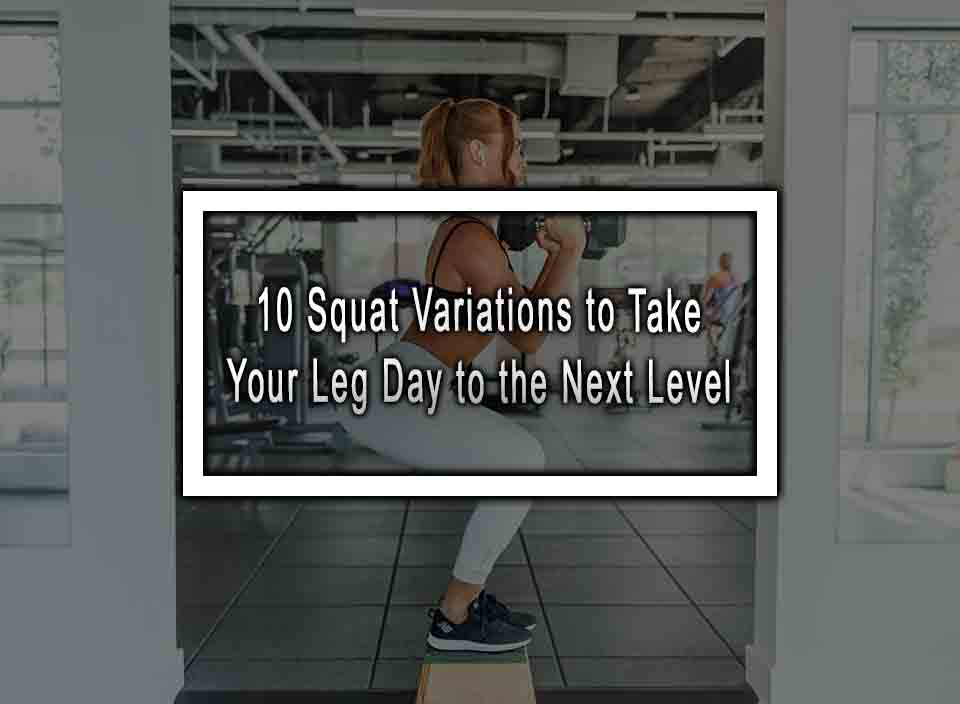Table of Contents
ToggleSquat Variations: Get Ready to Squat Your Way to Stronger Legs and Booty
If you’re tired of the same old squats, it’s time to switch up your leg day routine with these 9 squat variations that will challenge your legs like never before! From targeting different muscle groups to adding an extra element of fun and intensity, these squats will help you build strength, improve flexibility, and sculpt your lower body. So, grab your workout gear and get ready to squat your way to epic gains!
1. Goblet Squats
Targeting your quads, hamstrings, and glutes, goblet squats are a fantastic alternative to traditional squats. Hold a dumbbell vertically against your chest and perform squats, keeping your core engaged and heels grounded.
2. Sumo Squats
Channel your inner sumo wrestler with sumo squats. Take a wider stance, point your toes outwards, and lower your body down into a squat. This variation mainly hits your inner thighs, glutes, and quads.
3. Bulgarian Split Squats
Unilateral exercises like Bulgarian split squats help to correct muscle imbalances. Stand in a lunge position with your rear foot elevated on a bench or step. Lower your body by bending your front knee, keeping your back straight. These squats work your quads, hamstrings, and glutes.
4. Pistol Squats
Mastered traditional squats? Give pistol squats a try! Start by standing on one leg and squatting down, extending your other leg out in front of you. This challenging variation targets your quads, glutes, and core stability.
5. Jump Squats
Get your heart rate pumping with jump squats. Perform a regular squat, then explode upwards into a jump, land softly, and immediately go into the next rep. This explosive move activates your fast-twitch muscle fibers and increases power.
6. Plyometric Squats
Take jump squats up a notch with plyometric squats. Begin in a low squat position, then explode upwards while swinging your arms overhead. Land softly and go straight into the next repetition. Plyometric squats enhance power, strength, and vertical leap.
7. Prisoner Squats
Keep your upper body engaged with prisoner squats. Place your hands behind your head, interlocking your fingers, and perform regular squats. This variation improves posture, targets your quads and glutes, and activates your core.
8. Overhead Squats
Overhead squats challenge your core stability, shoulder mobility, and overall strength. Hold a weight or a barbell at shoulder height or overhead, and perform squats while keeping proper form. This variation engages your quads, glutes, shoulders, and upper back.
9. Wall Squats
A variation that focuses on building lower body endurance, wall squats involve leaning your back against a wall, sliding down until your thighs are parallel to the floor, and holding the position. This isometric exercise targets your quads, glutes, and hamstrings.
Conclusion
Incorporating these 9 squat variations into your leg day routine will not only spice up your workouts but also help you build strength, improve flexibility, and tone your lower body muscles. Remember to always use proper form, challenge yourself, and listen to your body. So, grab your favorite squat variation, prepare to feel the burn, and never skip leg day again!
Squat Variations FAQ
Here are the most common questions about squat variations.
1. Why should I do squat variations?
Squat variations can help to add variety and challenge to your workout routine. They can target different muscles or muscle groups, prevent boredom, and help to break through plateaus. Additionally, squat variations can be used to target specific weaknesses or imbalances in your lower body.
2. Are squat variations suitable for beginners?
Some squat variations may be more challenging than others, so beginners may want to start with the basic squat before progressing to more advanced variations. It’s important to master proper form and technique before attempting more difficult variations to prevent injury.
3. How many reps and sets should I do for squat variations?
The number of reps and sets will depend on your fitness level and goals. Aim for 8-15 reps per set and perform 2-4 sets per exercise. Beginners may start with fewer reps and sets and increase gradually as they build strength and endurance.
4. Are squat variations suitable for people with knee or hip problems?
People with knee or hip problems should consult with a healthcare professional before attempting squat variations. Some squat variations may put excessive strain on the knees or hips, so modifications or alternative exercises may be recommended for individuals with existing conditions or injuries.
5. How often should I perform squat variations?
The frequency of squat variations will depend on your overall training program and goals. Generally, aim to include squat variations 2-3 times per week, allowing for adequate rest and recovery between sessions.












